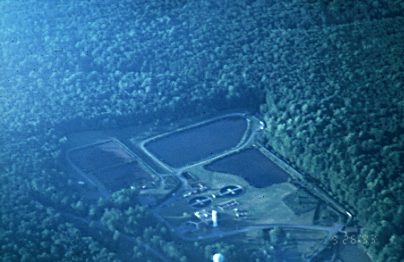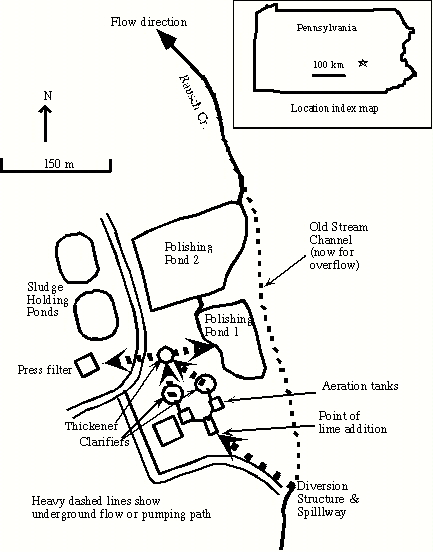
Rausch Creek Mine Drainage Treatment Facility near Valley View, PA
Photo courtesy of Carl S. Kirby, Bucknell University
This active treatment facility was constructed by the PA Dept. of
Environmental Resources in 1972 for approximately $4 million, and costs
approximately $400,000 per year to operate. It removes contaminants
very effectively. Few active treatment systems such as these are being
constructed by the government at abandoned mine discharges due to high
building and maintenance costs despite the fact that mining compaies
must comply with state-mandated effluent standards or face stiff fines.
Today, active mining operations still build similaractive treatment
systems since the technology is well understood. Passive technologies
are still relatively experimental. However, the science of passive treatment
is becoming better understood, and the passive treatment systems do
not fail catastrophically. If power is lost to an active treatment site,
or if a company goes bankrupt, active treatment stops.
Below is a map view diagram of the Rausch Creek Mine Drainage Treatment
Facility, an example of an active treatment facility. Except at very
high flows, all of Rausch creek is diverted into the facility. Ca(OH)2
is added as a slurry at the flash mixer, and air is added in the oxidation
tanks. There are two clarifiers which are followed by single thickener.
The slurry from the bottom of the thickener is pumped either to the
sludge holding tanks or to a belt filter press. The sludge is transported
to a nearby mine strip pit for disposal. Water from the top of the clarifiers
flows by gravity to the polishing ponds. The downstream polishing pond
holds brown trout.

Diagram courtesy of Carl S. Kirby, Bucknell
University
Return
to AMD Stakeholders' page
